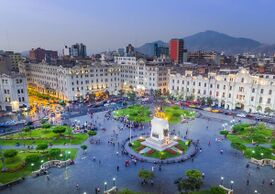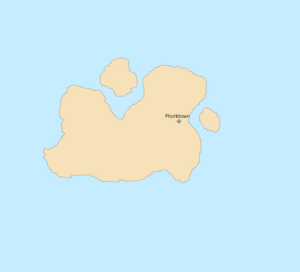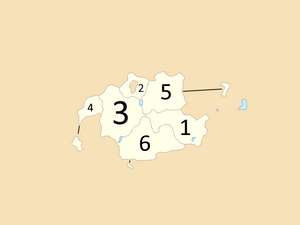Phorktown
This article is incomplete because it is pending further input from participants, or it is a work-in-progress by one author. Please comment on this article's talk page to share your input, comments and questions. Note: To contribute to this article, you may need to seek help from the author(s) of this page. |
Phorktown | |
|---|---|
City | |
| Other transcription(s) | |
| • Chinese | 福克敦 |
| • Spanish | Phorktown |
 The Central Square | |
| Nickname: PT | |
| Motto(s): Born in freedom, live in freedom, die in freedom | |
| Country | Philimania |
| Province | New Cardiff |
| Districts | List |
| Establishment | 23 May 1632 |
| City status | 5 March 1680 |
| Government | |
| • Type | Mayor–Council |
| • Body | Phorktown City Council |
| • Mayor | William Grey |
| Area | |
| • Total | 1,222 km2 (472 sq mi) |
| • Metro | 553 km2 (214 sq mi) |
| Elevation | 5 m (16 ft) |
| Population (2019) | |
| • Total | 1,765,200 |
| • Density | 1,444/km2 (3,740/sq mi) |
| • Urban | 785,324 |
| • Metro | 979,876 |
| • Metro density | 1,772/km2 (4,590/sq mi) |
| • Demonym | Phorker |
| City Index | |
| • HDI (2019) | |
| • GDP (2020) | |
| • Per capita (2020) | |
| Time zone | UTC-8 (GMT-6) |
| Postal code | 800 to 40000 |
| Area code(s) | 45, 46 |
| Vehicle registration | T (except taxis) NC (for taxis only) |
| Rapid Transit | |
| Official language(s) | English Spanish (de facto) |
| Website | www.pt.gov |
Phorktown City, often called simply Phorktown, is the second populous city in the Philimania. With an estimated 2019 population of 1,765,200 distributed over about 1,222 km2 (472 sq mi). The city is located at the Northeastern tip of the province of New Cardiff.
Situated on one of the world's largest natural harbors, Phorktown is composed of six districts. The six districts—Wellam, Brake, East Phorktown, Admira, Flinthead, and Beadrun—were created in 1680, after city status was granted to the city. As many as 600 languages are spoken in Phorktown, making it one of the most linguistically diverse city in the world. Phorktown is home to roughly 1 million residents born outside Philimania. As of 2019, Phorktown is estimated to produce a GDP of P$342,635 billion.
Phorktown traces its origins to a trading post founded by a buisnessman named Jacob Phork in 1632. Phorktown saw one of the longest battle in human history known as the Battle of Phorktown Hill which led to the surrender of Philimania to Long Kingdom and Spain. In the 21st century, Phorktown has emerged as a global node of cultural diversity.
Etymology
THe city was named after the founder of the city—Jacob Phork.
History
Early History
A permanent Philimanian presence in what is now Phorktown began in 1632 with the founding of the wood industry in the area. In 1636, construction was started on a citadel called Fort Phork, on present-day Beadrun District.
Following the construction of Fort Phork, Phorktown grew slowly. Settlers form the coast were encouraged to move to Phorktown to find work, aand the area began to thrive.
Since 1640, the Phork Trade Company had operated as a monopoly in Philimania, on authority granted by the Governer of Philimania. In 1643–1657, in an effort to bolster economic growth, the Phork Trade Company relinquished its monopoly over the wood industry, leading to growth in the production and trade of food, timber, and tobacco.
In 1666, the Phorktown City Council was formed. Shortly after the council's formation, the population of Phorktown grew from 1,500 to 9,000. Charles Peters, the first mayor, has been credited with improving law and order in Phorktown; however, he also earned a reputation as a despotic leader. He instituted regulations on liquor sales, attempted to assert control over the Church, and blocked other religious groups from establishing houses of worship. The Phork Trade Company would eventually attempt to ease tensions between Peters and residents of Phorktown.
In 1680, the city was named the capital of Philimania and it became a major South American economic hub.
The Long Kingdomian Revolution
Following The Seven Years War, in 1768, Philimania's economy deteriorated. So on July 23rd in that year, the president at that time, Kareen Rallington passed an act known as the Comertua Act, it states that taxes in Largoia, modern day Long Kingdom would be raised by 20% and that Philimanian goods bought or sold would cost twice as much. The Largoian were not happy.
In 1768, a Largoian revolutionist and around 500 other Largoians took to the streets of Browningham, the capital of Largoia. After a series of protests, the Philimanian soldiers were sent in to deal with the protesters. as soon as the army entered the city, rocks were thrown at them. The soldiers, overwhelmed by the number of protesters, they fired into the crowd. many protesters were killed and this event would be known as the Browningham Massacre. The news of this event spreaded like wildfire. The Largoian were outraged, so they armed themselves with weapons and revolted against Philimania.
The Long Kingdomian Revolution started on August 10th 1768. The general of the Philimanian army, launched an all-out assault on the beaches of Largoia with insignificant losses. By October, the Long Kingdomian Revolution seemed to be coming to a close for all Long Kingdomian units have either been surrounded or captured; But, a month ago, a Long Kingdomian ambassador was sent to Spain to ask them for help, the Spanish agreed. So on the 5th of November in that year, Philimanian forces were driven off the island, but not after a final stand at the Battle of Pices Beach. It was estimated that Spain and The Long Kingdom suffered twice as much as Philimania.
By February 1769, Spanish and Long Kingdomian forces were pushing Philimanian forces into their own island. Eventually, they reached Phorktown, where the Philimanians made a last-ditch attempt to drive out their enemy at the Battle of Phorktown hill in Brake. Both sides suffered heavy losses, the battle lasted for a total of 13 months and ended in the destruction of most of Phorktown and Philimania's surrender on March 15th 1770 ending the Long Kingdomian Revolution.
Nineteenth Century

Over the course of the nineteenth century, Phorktown's population grew from 40,000 to 1.1 million.
The Great Irish Famine brought a large influx of Irish immigrants; more than 100,000 were living in Phorktown by 1860. There was also extensive immigration from the German provinces, where revolutions had disrupted societies, and Germans comprised another 15% of Phorktown's population by 1880.
In 1899, the capital was moved from Phorktown to New Phork by President Mahad Sanders.
Modern Era
The opening of the Phorktown Subway in 1911, first built as separate private systems, helped bind the new city together. Throughout the first half of the 20th century, the city became a South American center for industry, commerce, and communication.
From 1940-1980, thousands of immigrants came to Philimania to find work, many of them came to Phorktown, which is why the city has emerged into the 21st century as a city of cultural diversity
Geography
Phorktown is situated at the north of New Cardiff, a few miles south of New Phork. The city's total area is 1,222 km2 (472 sq mi), with an average elevation of 5 m (16 ft).
Climate and weather
Phorktown experiences a humid tropical climate with generally cool temperatures and plentiful rainfall all year round. Temperatures tend to remain constant. Maximums hover between 24 and 31 °C (75.2 and 87.8 °F) and sometimes hit 38 °C (100.4 °F), while minimums hover between 18.4 °C (65.12 °F) and have never fallen below 17.8 °C (64.0 °F).
| Climate data for Phorktown | |||||||||||||
|---|---|---|---|---|---|---|---|---|---|---|---|---|---|
| Month | Jan | Feb | Mar | Apr | May | Jun | Jul | Aug | Sep | Oct | Nov | Dec | Year |
| Record high °C (°F) | 23.0 (73.4) |
22.8 (73.0) |
22.0 (71.6) |
23.8 (74.8) |
22.2 (72.0) |
21.9 (71.4) |
25.0 (77.0) |
23.2 (73.8) |
23.4 (74.1) |
22.0 (71.6) |
22.7 (72.9) |
23.0 (73.4) |
25.0 (77.0) |
| Average high °C (°F) | 21.0 (69.8) |
23.8 (74.8) |
25.1 (77.2) |
24.1 (75.4) |
23.0 (73.4) |
22.8 (73.0) |
24.8 (76.6) |
22.3 (72.1) |
22.1 (71.8) |
25.0 (77.0) |
24.7 (76.5) |
23.5 (74.3) |
23.5 (74.3) |
| Daily mean °C (°F) | 23.7 (74.7) |
22.2 (72.0) |
24.6 (76.3) |
21.7 (71.1) |
22.8 (73.0) |
26.6 (79.9) |
24.1 (75.4) |
22.1 (71.8) |
23.0 (73.4) |
24.0 (75.2) |
22.8 (73.0) |
21.6 (70.9) |
23.3 (73.9) |
| Average low °C (°F) | 19.4 (66.9) |
20.6 (69.1) |
19.0 (66.2) |
21.3 (70.3) |
19.6 (67.3) |
21.3 (70.3) |
20.8 (69.4) |
18.9 (66.0) |
20.8 (69.4) |
21.0 (69.8) |
20.8 (69.4) |
19.6 (67.3) |
20.3 (68.4) |
| Record low °C (°F) | 17.8 (64.0) |
18.0 (64.4) |
18.9 (66.0) |
20.6 (69.1) |
20.5 (68.9) |
19.1 (66.4) |
20.1 (68.2) |
20.0 (68.0) |
21.0 (69.8) |
20.0 (68.0) |
20.7 (69.3) |
19.0 (66.2) |
17.8 (64.0) |
| Average precipitation mm (inches) | 193 (7.6) |
198 (7.8) |
257 (10.1) |
230 (9.1) |
197 (7.8) |
131 (5.2) |
148 (5.8) |
162 (6.4) |
214 (8.4) |
265 (10.4) |
321 (12.6) |
252 (9.9) |
2,568 (101.1) |
| Average rainy days | 15 | 17 | 20 | 21 | 20 | 24 | 20 | 21 | 19 | 18 | 18 | 17 | 230 |
| Average relative humidity (%) | 80 | 80 | 80 | 82 | 81 | 80 | 79 | 79 | 81 | 82 | 84 | 83 | 81 |
| Mean monthly sunshine hours | 185.0 | 192.4 | 207.9 | 198.8 | 206.8 | 194.4 | 200.2 | 189.0 | 163.8 | 169.1 | 152.3 | 162.6 | 2,222.3 |
| Climate data for Phorktown | |||||||||||||
|---|---|---|---|---|---|---|---|---|---|---|---|---|---|
| Month | Jan | Feb | Mar | Apr | May | Jun | Jul | Aug | Sep | Oct | Nov | Dec | Year |
| Mean daily daylight hours | 12.0 | 12.0 | 12.1 | 12.2 | 12.3 | 12.3 | 12.3 | 12.2 | 12.1 | 12.0 | 12.0 | 11.9 | 12.1 |
| Average Ultraviolet index | 12 | 12 | 12 | 12 | 12 | 12 | 12 | 12 | 12 | 12 | 12 | 12 | 12 |
Military installations
Beadrun is home to Fort Phork, the Philimanian military's only active duty installation within Phorktown. The facility was established in 1636, and it is Philimania's longest serving military forts. Today Fort Phork serves as the headquarters of the 2nd Division of the Philimanian Armed Forces and for the Phorktown City Recruiting Battalion. It also houses the 7th Transportation Brigade, the 1st Aeromedical Staging Squadron, and a military entrance processing station.
Governance
Phorktown was administered by the Phork Trade Company from the city's founding on 23 May 1632, until 8 February 1666, after which executive power transferred to the Phorktown City Council. Seventeen mayors have been appointed since then. The current mayor is William Grey of the Green Party, who has been in office since 17 May 2017.
Local government
The local administration is carried out by the Phorktown City Council. It is responsible for public health and sanitation, waste removal and management, town planning, environmental protection and building control, social and economic development, and general maintenance functions of urban infrastructure. Executive power lies with the mayor in the city hall, who is elected for 20 years by the public. This system of electing the mayor has been in place ever since the founding of the City Council.
Districts
Phorktown's six districts, with estimated population and percentage of the total, are congruent with administrative subdivisions under the authority of the Phorktown City Council.
Demographics
Population density
Phorktown is the second most populous city in Philimania, with a population of 1.7652 million in the city proper as of 2019. It has a population density of 1,444 inhabitants per square kilometre (3,740/sq mi), and is the most densely populated administrative district in Philimania.
Race and ethnicity
Phorktown's populace includes many ethnic groups such as Philimanian, Haspanic, Afro-Ecuadorian, German, Han Chinese, Ibans Irish, Jews, Italians, and other indigenous races from around South America.
Approximately 60% of the city's population is foreign born, and more than half of all children are born to mothers who are immigrants as of 2020. In Phorktown, no single country or region of origin dominates. The ten largest sources of foreign-born individuals in the city as of 2021 were Peru, China, Mexico, Namibia, Poland, Ecuador, Ireland, India, Russia, and Trinidad and Tobago.



